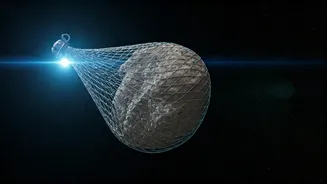Decathlon's Space Leap
Decathlon, typically associated with affordable sports equipment, has taken an unexpected step by designing a space suit. This initiative highlights the
company's continuous pursuit of innovation and its willingness to embrace uncharted territories. The move demonstrates Decathlon's intent to apply its expertise in designing functional and durable gear to an entirely new domain. The creation of a space suit signifies the company's dedication to pushing the boundaries of what's possible, expanding its brand identity, and appealing to a broader audience that goes beyond just sports enthusiasts. It represents a bold move to leverage their existing design and manufacturing capabilities in a futuristic and highly demanding field, potentially changing the public's perception of the brand's potential and adaptability.
Design and Engineering
The process of designing a space suit is incredibly complex, requiring meticulous attention to detail and a profound understanding of the extreme conditions in space. Decathlon's team likely had to navigate numerous challenges, from ensuring the suit's structural integrity to providing life support systems. Engineers had to consider factors such as extreme temperature fluctuations, radiation exposure, and the need for mobility and comfort. The suit's design probably involved advanced materials capable of withstanding the harsh environment. The engineering aspects would have involved creating a pressurized environment to protect the astronaut, integrating a communication system, and enabling movement within the spacecraft or on the surface of another celestial body. Decathlon's approach likely integrated innovative features that built on their history of creating practical, user-friendly equipment, showcasing their adaptable engineering skills.
Materials and Technology
Space suit development required the use of cutting-edge materials and technologies. The selection of materials played a critical role in the suit's performance. The outer layers had to offer protection against micrometeoroids and radiation, possibly incorporating multi-layered fabrics with reflective coatings. The suit's internal systems would have incorporated advanced life support, including oxygen tanks, carbon dioxide scrubbers, and temperature regulation mechanisms. Advanced communication systems would also be included. These components needed to be lightweight, durable, and reliable to endure the extreme environment. The integration of advanced sensors and data processing capabilities, possibly utilizing smart textiles, would have provided real-time feedback on the astronaut's condition and the suit's performance, enhancing safety and operational effectiveness.
Beyond Sportswear
This venture into space suit design extends Decathlon’s brand beyond its usual sportswear niche. It indicates a strategic shift towards innovation and engineering expertise. By venturing into a field as complex and challenging as space exploration, Decathlon showcases its ability to transcend its traditional boundaries and redefine its brand identity. It also demonstrates the versatility of the company's research and development resources, which could be leveraged to tackle a wide variety of engineering challenges. This could open doors for collaborations with space agencies or aerospace companies, and expand the company's range of business ventures. This strategic diversification signals a forward-thinking approach, positioning the company as a leader in technological advancement.
Future Implications
Decathlon's entry into the space sector might bring innovative approaches to the world of space exploration and could have several long-term implications. The technologies and materials developed for space suits may lead to advancements in other areas, such as protective gear for extreme environments here on Earth, including military and industrial sectors. The company's involvement in space may also increase public awareness of space exploration, possibly encouraging greater engagement. Furthermore, it could inspire future generations of engineers and scientists by highlighting the importance of innovation and the possibility of applying scientific and technical expertise to solve some of the world's most difficult problems. Decathlon’s leap into space might just be the start of a new era of cross-industry collaboration and technological advancements.











